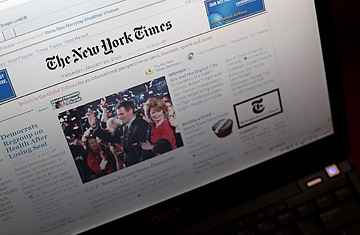
The New York Times website, displayed on a laptop
A big printed shoe fell on Wednesday, when the New York Times partially lifted the veil on its plan to charge for access to its website. Speculation has been rife in media circles on how the nation's most influential and successful paper would go about touching what some consider to be the third rail of Web content. The Times' answer? Very gingerly. In effect, the paper seems to be asking its readers, Don't you really actually want to pay for us?
The plan, while still in its infancy, appears to be targeting the website's most frequent readers. Most of the visitors to NYTimes.com pop in infrequently, directed there by search engines and Web aggregators like the Huffington Post or the Drudge Report. For those people, things will not change much come 2011, when the plan is due to go into effect. But heavier users of the site, like those who fire up the computer in the morning to see what the Times has to say, will have to spend. The plan appears similar to that pursued by London's Financial Times. If it works anything like FT.com, after viewing a certain number of articles, readers will be directed to a page where they have to subscribe if they want more of the Times' newsy goodness. Old-school newspaper subscribers, bless their hearts, will get access for free.
Of course, frugal readers could go back to the HuffPo or Google and re-enter the site through an alternate route. There will no doubt be workarounds, but the Times seems to suspect that many people won't bother. They'll just subscribe, because after all, it's the freakin' New York Times and people surely want to pay for that kind of quality journalism.
Many of the crucial details have yet to be ironed out: How many pages will people be able to see for free? By what mechanism will people pay? Will it be a paywall or more of a metered system? Can you pay not to get Maureen Dowd? "This announcement allows us to begin the thought process that's going to answer so many of the questions that we all care about," company chairman and publisher Arthur Sulzberger Jr. deflectingly told his own paper. "We can't get this halfway right or three-quarters of the way right. We have to get this really, really right."
He's not wrong about the last part. As the news business continues to struggle across the country — the owners of the Denver Post have just become the 13th newspaper company in as many months to announce their filing for bankruptcy protection — many newspapers are trying to figure out ways of cauterizing the losses. Charging for content is a favorite; Rupert Murdoch has announced he will do the same for all his newspaper companies in the near future.
The appeal of the Times' approach is that while it doesn't cut the paper off completely to all those ad-revenue-generating eyeballs, it also doesn't continue to give away the store for free. The downside is that it's neither fish nor fowl: people who might pay for the paper are still going to try to get it for free if there's a way to do so. At the same time, the pay plan will limit the website's traffic — at 17 million monthly readers, it's the biggest of the newspaper websites — and therefore its ad moola.
The Times has tried the charging-for-content trick twice before. In the early days of the Internet, it charged for access from overseas readers, and from 2005 to 2007, it tried TimesSelect, in which readers had to pay for access to its signature columns and opinion pieces. That experiment was abandoned, perhaps partly because the writers chafed at the limits this put on their reach, but also because it limited the advertising play. TimesSelect attracted 210,000 people, according to the newspaper, at about $50 a throw. As the recession set in and the Times' balance sheet began to look more reddish, executives may have come to mourn that lost $10 million.
